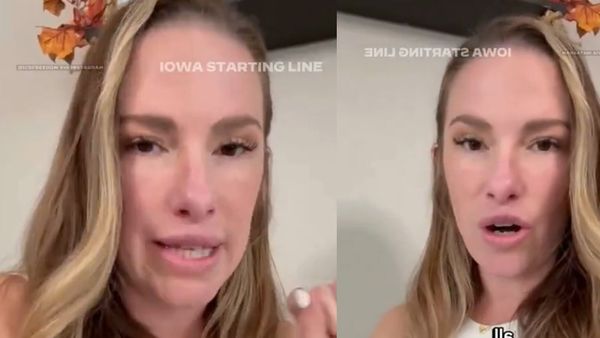
Awash in soft, peach-colored light, the infant yawns, sticks her thumb in her mouth and flutters her eyes at the camera. As the camera pulls away from her, an umbilical cord and the fleshy tunnel surrounding the infant comes into focus. This isn’t a newborn baby: it’s a fetus in a disembodied womb.
“This is Olivia,” a British female voice narrates. “Though she has yet to greet the outside world, she has already completed an amazing journey.”
Say hello to “Meet Baby Olivia”, an animated video made by an American anti-abortion group that purports to depict humans’ embryonic and fetal development in an alleged effort to convert young people to the anti-abortion cause. The video – or something very close to it – will be required viewing for public school students in two states, with several more potentially on the way.
Last year, North Dakota became the first state in the nation to pass a law mandating that schools screen “Meet Baby Olivia” or a similar video. This year, Tennessee enacted its own “Meet Baby Olivia” law, requiring that “Meet Baby Olivia” or something like it be shown as part of schools’ sex education curriculum.
So far in 2024, legislators in at least 10 other states have introduced bills that would require schools to show students “Meet Baby Olivia” or, in language that appears repeatedly throughout the bills, a similar “high-quality, computer-generated rendering or animation” that shows “every stage of human development inside the uterus, noting significant markers in cell growth and organ development for every significant marker of pregnancy until birth”. Including Tennessee’s legislation, bills in at least five of the states cite “Meet Baby Olivia” by name.
Classrooms are a burgeoning front in the post-Roe v Wade abortion wars, as conservative activists have increasingly intertwined their attacks on abortion with their distaste for sex ed that discusses alternatives to premarital abstinence. But medical professionals have accused the anti-abortion group behind “Meet Baby Olivia” of spreading propaganda and even misinformation in order to convert young people to their cause.
Seven of the 12 states where the bills have been introduced or passed ban almost all abortions. So far this year, state legislatures have considered at least 135 sex-ed bills – a record number, according to a CNN analysis. Sixty per cent of them would restrict sex ed in some way.
Live Action has denied accusations that any sentence of “Meet Baby Olivia” is inaccurate.
“‘Baby Olivia’ isn’t about abortion. It never says the word ‘abortion’,” said Noah Brandt, Live Action’s vice-president of communications. “‘Baby Olivia’ is an important place for states like Tennessee and North Dakota to turn to next, to continue to do work to educate on both biology and life, because they’ve already protected life so now it’s about teaching people when life begins and to respect that.”
A quiet success story
The emergence of the “Meet Baby Olivia” legislation comes at a precarious time for the anti-abortion movement. Since the overturning of Roe, support for abortion rights has mounted even in conservative states. Some Republicans have tried to downplay their opposition to the procedure or even supported efforts to protect it, in a sharp departure from decades of marching in lock step with the anti-abortion movement.
But as the anti-abortion movement flounders, the “Meet Baby Olivia” bills are a quiet success story. Abortion opponents overturned Roe by spending years pushing for state-level abortion restrictions; if a restriction was successful in one state, lawmakers in other states would copy-paste its language and introduce their own versions. This strategy gnawed away access to abortion.
In the “Meet Baby Olivia” bills, observers see a similar strategy at play – and evidence of mission creep.
“Anti-abortion, anti-sexual and [anti]-reproductive health movements have been focusing on other areas and expanding their scope in terms of what is relevant to them and what they’re working on,” said Kimya Forouzan, principal policy associate of state issues at the Guttmacher Institute, which supports abortion rights. Although Guttmacher tracks restrictions on sexual and reproductive health, Forouzan said that she had never before seen legislation quite like the “Meet Baby Olivia” bills.
“We’ve seen a lot of attempts at omitting information from sex ed,” she said. “But this is such an explicit effort to put misleading curriculum into sex ed.”
The American College of Obstetricians and Gynecologists, the pre-eminent US membership organization for OB-GYNs, issued a statement denouncing “Meet Baby Olivia” as “designed to manipulate the emotions of viewers rather than to share evidence-based, scientific information about embryonic and fetal development”.
The organization continued: “Many of the claims made in this video are not aligned with scientific fact, but rather reflect the biased and ideologic perspectives of the extremists who created the video.”
In “Meet Baby Olivia”, the narrator says that life begins when a sperm fertilizes an egg, but there is no scientific consensus on when life starts – and it is as much a philosophical and religious question as a scientific one. The narrator also says that “Olivia’s heartbeat can be detected” roughly three weeks after fertilization, or five weeks after the first day of a woman’s last menstrual period, which is what the medical establishment uses to calculate a pregnancy’s length. At that point in pregnancy, the embryo does not yet have a fully developed heart.
“I would say we could start to see activity that could be a cardiac activity, maybe around six weeks to seven weeks of pregnancy,” said Dr Stacy Sun, a New York-based OB-GYN and fellow with Physicians for Reproductive Health. “The question is whether or not that’s a heartbeat as another question, because that’s not really a fully formed heart.
“If we’re getting down to the nitty-gritty of what’s medically accurate, those words aren’t medically accurate,” she added.
“Meet Baby Olivia” also claims that, 20 weeks after fertilization – or 22 weeks of pregnancy – “with a lot of help, babies have survived outside the womb”.
Fetal viability, or the point at which an infant can survive outside the womb, is typically dated at around 22 weeks after fertilization, or 24 weeks of pregnancy. While there have been cases of babies surviving after being born just 20 weeks after fertilization, fetal viability is attenuated to each individual pregnancy, particularly since many regions of the United States lack adequate OB-GYN facilities or expertise, which could help women who give birth too early. The most premature baby to ever survive, according to Guinness World Records, was born 19 weeks and 1 day after fertilization. He stayed in an Alabama hospital for 275 days.
“There’s so many nuances when it comes to whether or not a baby can survive, especially when they’re that young,” Sun said. “Even if they do survive, they don’t have a great quality of life. The effect of it can be devastating on the person carrying the pregnancy, the baby.”
On the “Meet Baby Olivia” YouTube page, Live Action says that the video has been “reviewed by accredited medical professionals”. Two of the professionals who are cited as reviewing “Meet Baby Olivia” work for the Charlotte Lozier Institute, the research arm of the powerful anti-abortion group Susan B Anthony Pro-Life America. Another is a doctor who is credited as, at the time, working for the American College of Pediatricians, an organization that the Southern Poverty Law Center has labeled an anti-LGBTQ+ hate group.
“Our medical recommendations are evidence-based and focused on fostering children’s optimal physical and emotional health and well-being. Any label to the contrary is simply false,” the American College of Pediatricians said in a statement. On its website, which says the group is not anti-LGBTQ+, the organization says that children are better off when raised by married heterosexual couples rather than same-sex couples and that “same-sex sexual behavior is associated with serious physical and psychological health risks at significantly high rates”.
In at least two states, West Virginia and Iowa, “Meet Baby Olivia” bills passed one legislative chamber, but both state legislatures have now shuttered for the year. Most of the legislatures that introduced “Meet Baby Olivia” bills have either ended their 2024 sessions or are set to do so in the next few weeks.
Compared to the rest of the country, the states that have introduced “Meet Baby Olivia” bills this year – which also include Georgia, Hawaii, Kentucky, Michigan, Missouri, Pennsylvania, and South Carolina – have less comprehensive sex-ed policies, according to Siecus: Sex Ed for Social Change, a decades-old organization that issues best practice guidelines for comprehensive sex ed. (None of the states garnered more than a C grade in the Siecus ranking system.) Most states do not require public school sex ed to be medically accurate, culturally appropriate or unbiased, according to Guttmacher. Only four states say that sex ed cannot promote religion.
Brandt argues that information about “human development” needs to be included in sex ed, because “the creation of a new human” is a potential consequence of sex.
Asked if the anti-abortion movement should get more involved in shaping sex ed, Brandt answered: “Yeah, definitely, yes.”







